Book contents
- Frontmatter
- Contents
- Foreword by Andrew Fire
- Foreword by Marshall Nirenberg
- List of Contributors
- Introduction
- Section one Basic RNAi, siRNA, microRNAs and gene-silencing mechanisms
- Section two Design, synthesis of siRNAs
- Section three Vector development and in vivo, in vitro and in ovo delivery methods
- Section four Gene silencing in model organisms
- Section five Drug target validation
- Section six Therapeutic and drug development
- Section seven High-throughput genome-wide RNAi analysis
- Index
- Plate section
Introduction
Published online by Cambridge University Press: 31 July 2009
- Frontmatter
- Contents
- Foreword by Andrew Fire
- Foreword by Marshall Nirenberg
- List of Contributors
- Introduction
- Section one Basic RNAi, siRNA, microRNAs and gene-silencing mechanisms
- Section two Design, synthesis of siRNAs
- Section three Vector development and in vivo, in vitro and in ovo delivery methods
- Section four Gene silencing in model organisms
- Section five Drug target validation
- Section six Therapeutic and drug development
- Section seven High-throughput genome-wide RNAi analysis
- Index
- Plate section
Summary
“If the RNAi technology can be made to work, there's a long list of diseases it can be applied to.”
–Phillip A. Sharp, Nobel laureate, MIT From CBSNews.com July 18, 2003Gene Expression (genomics) is a new discipline within molecular biology that narrates the functional organization of genes. Most of you are aware of the terms Genome (study of the expression of all the genes in an organism known as Genomics), Proteome (study of the expression of all the proteins in an organism known as Proteomics), and Glycome (study of the expression of all the glycoproteins in an organism known as Glycomics). Another scientific buzz word that is spreading fast in the research community these days is RNome, the RNA equivalent of the ‘proteome,’ ‘genome’ or ‘glycome,’ with the subject referred to as RNomics. RN omics is a newly emerging sub-discipline that categorically studies the structure, function and processes of noncoding RNAs and the mechanism of RNA interference in a cell.
RNA Interference Technology: From Basic Science to Drug Development is primarily intended for readers in the molecular cell biology and genomics fields but may be useful in more advanced graduate level courses. Much of the text should be of interest to those in applied sciences such as molecular medicine, genome science, and biotechnology. This book, which focuses on the concepts of basic RNAi biology and applications in drug development, consists of thirty four chapters, grouped into seven sections.
- Type
- Chapter
- Information
- RNA Interference TechnologyFrom Basic Science to Drug Development, pp. 1 - 14Publisher: Cambridge University PressPrint publication year: 2005



